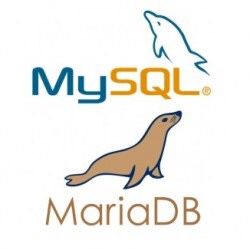As part of the migration of my MacOS Server to Linux the next service to migrate is my PostgreSQL engine. Although PostgreSQL had already been hidden in MacOS Server for some time, it still was included (as internal services like ProfileManager and Calendar and Addressbook Server depend on it. Despite it being hidden, I had still enabled it (manually) and hosted my PostgreSQL databases on my MacOS Server for ages. Despite migrations sometimes being a pain (i.e. not automatic) this worked well so far, including integrating it with the MacOS Server way of using transaction logs for offline backups. (so I will also have to look for a new way to do this). Continue reading “MacOS Server Replacement #2 – Migrating PostgreSQL”
MacOS Server Replacement #1 – Migrating MySQL to MariaDB
As part of the migration of my MacOS Server to Linux the first service to migrate is my MySQL 5.7 engine. Although MySQL is not part of MacOS Server anymore for a long time (and I had installed it separately), I will cover the migration here as 1) I still had it running on my MacOS Server and 2) the migration wasn’t smooth so decided to share my learnings here. Continue reading “MacOS Server Replacement #1 – Migrating MySQL to MariaDB”
Apple totally strips MacOS Server
Today I noticed that there was a new update for MacOS Server that had quite a lengthy explaination:
 As per Apple Knowledge Base article HT208312, the once great Apple Server product as this fall will be reduced to:
As per Apple Knowledge Base article HT208312, the once great Apple Server product as this fall will be reduced to:
- Profile Manager
- Open Directory
- Xsan
The rationale of this is, according to Apple:
In fall 2018, Apple will stop bundling open source services such as Calendar Server, Contacts Server, the Mail Server, DNS, DHCP, VPN Server, and Websites with macOS Server. Customers can get these same services directly from open-source providers. This way, macOS Server customers can install the most secure and up-to-date services as soon as they’re available.
Resolved Apple CalDav issues with PostgreSQL startup
Today I noticed that my phone could no longer create any new calendar items. With Server.app I noticed that the Calendar (and AddressBook) services were no longer running and when checking their status, it took forever for the panel to load. Enabling the service again also took forever to not start (and unfortunately without any error message).
After some digging I found that the PostgreSQL server the Apple CalDav service uses internally was no longer running and issues starting In the logfiles in /var/log/caldavd/postgresql/ I found messages like:
2015-03-14 12:59:33.665 CET [689] LOG: unexpected pageaddr 0/5DC82000 in log segment 000000010000000000000061, offset 13115392 2015-03-14 12:59:33.665 CET [689] LOG: invalid primary checkpoint record 2015-03-14 12:59:33.679 CET [689] LOG: unexpected pageaddr 0/5DC7C000 in log segment 000000010000000000000061, offset 13090816 2015-03-14 12:59:33.679 CET [689] LOG: invalid secondary checkpoint record 2015-03-14 12:59:33.679 CET [689] PANIC: could not locate a valid checkpoint record
I suspect these were caused by a crash a few days ago of my NAS that serves the iSCSI disks where the postgres data is stored. I spent a lot of time today to look for a solution (including trying to restore a backup and set it up from scratch, which all failed). In the end I found a clue in the manual page of pg_resetxlog:
DESCRIPTION
pg_resetxlog clears the write-ahead log (WAL) and optionally resets some other control information stored in the pg_control file. This function is sometimes needed if these files have become corrupted. It should be used only as a last resort, when the server will not start due to such corruption.
This pretty closely matched my situation so (after making a backup of the DB folder) I executed the following command in the folder where Server.app stores it data (by default that is /Library/Server/Calendar and Contacts but in my case that’s /Volumes/Data/Library/Server/Calendar and Contacts as I store all data on a RAID5 container on my NAS)
sudo -u _calendar pg_resetxlog -f Data/Database.xpg/cluster.pg/
After running this command the PostgreSQL for Services started again and my Calendar (and AddressBook) services were running again. So far it looks like I did not lose any data apart from a calendar entry that I had added on my Macbook in iCal.I am glad it is resolved, but I have to look into how backups are made so that the next time I at least know that I can get my calendar and contacts back…
Restoring OpenDirectory on Mac OS X Mountain Lion Server
After some more checking on the contents of the /Recovered Items folder left over after my failed upgrade of OS X from Lion to Mountain Lion I decided to proceed with re-installation of the components to see if I could get things back as they were again.
The first step was to install the Server component again (which has gone missing after the upgrade). This only took a simple purchase of the Server.app component in the App Store. After that I had a Mac Server again and could start my reinstallation.
The first component to reconfigure was the Open Directory component. It was extremely important for me not to lose that one as it contained all my users, their passwords and group membership as well as all the e-mail addresses each user had (I am hosting a few different domains, re-creating that would mean a lot of work).
When I enabled the Open directory server component, I had to specify how I wanted to configure that. This screen included an option to import a backup. As I still had the whole data structure from my previous installation, I tried that first but that did’t work. Then I noticed that the directory /Recovered Items/private/var/backups/ contained a file called ServerBackup_OpenDirectoryMaster.sparseimage that was less than a day old. I selected that file as backup, which was accepted to restore from and it looks like that did the trick. My users were restored and I could also login with my regular userID again.
Based on this initial success I decided to rebuild the rest of my server as I knew the other components (PostgreSQL, Postfix, Dovecot, etc) pretty well from when I hosted everything still on Linux… I will continue to document the steps I took as well as my custom setup as it may be useful for others.




